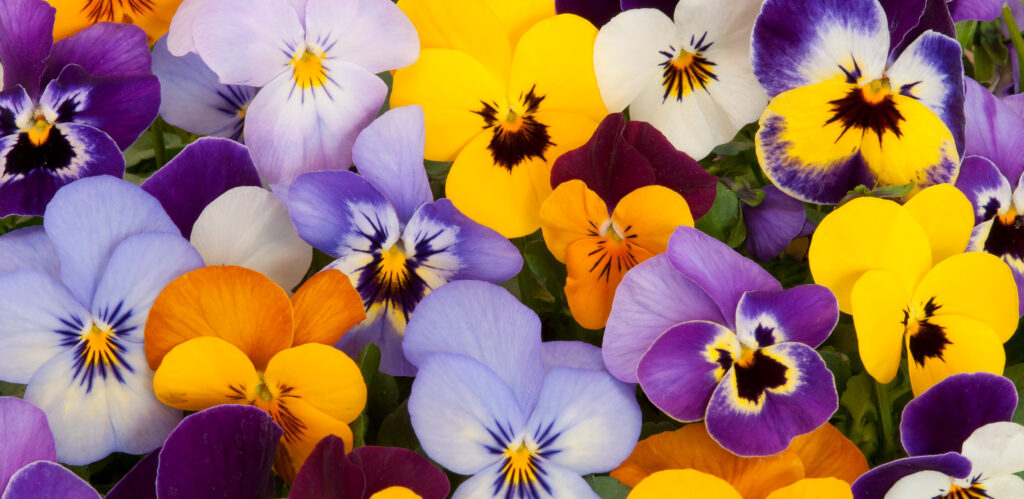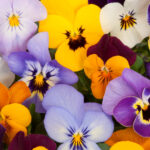Johnny Jump Ups!

Named for rapidly “jumping” up in size as temperatures warm after the winter, johnny jump ups are delightful little favorites for gardeners, especially during the spring! It’s not uncommon to hear the name jump up used interchangeably with viola or pansy, but these names all refer to different, but overlapping, groups of plants.
Johnny Jump Ups - Violas or Pansies?

Violas are a wildly diverse genus that includes pansies and jump ups and over 500 other species and varieties! With their five-petaled blossoms and heart-shaped leaves, these dainty but surprisingly hardy plants can be found on every continent except Antarctica.

While most violas possess small flowers that have evenly spaced petals with two pointing up and three pointing down, pansies are violas with larger blossoms and four upward-pointed petals with only one pointing downward. Combining aspects of both, jump ups have the flower size of normal violas with the distinctive petal arrangement of pansies.
Johnny Jump Ups have been cultivated and hybridized from their original versions in Europe and North America into hundreds of new varieties. These varieties usually have flowers with blotches of purple, yellow, white, or blue as well as the occasional pink, red, orange, bronze, or black. Jump up colors are also often displayed in gorgeous bicolor or even tricolor patterns and sometimes have fancy “whisker” stripe patterns running across their petals.

Most jump up varieties display these amazing colors in both the spring and fall, sometimes even stay in bloom over the summer in cool climates or overwintering in warm climates. These climate conditions also affect whether or not your jump ups are perennial or annual. Typically, most varieties are perennial from hardiness zones 4-8 but can sometimes still remain as reseeding annuals from zones 3-9.
Outside of their use in the garden, these flowers also have a rich history and profound cultural significance. Viola tricolor, a common jump up species and the wild ancestor of most modern pansies, was first seen in numerous ancient Greek myths mainly centered around themes of love and innocence. These associations stuck around in people's minds, leading to this species sometimes being called heartsease and even being referenced by Shakespeare in A Midsummer Night’s Dream as an ingredient for a love potion!

Plants in the viola genus are edible and can have a range of beneficial effects on our bodies. Jump up petals and leaves can be eaten both raw or cooked in a range of dishes, and are high in vitamin A, vitamin C, and antioxidants. In addition, jump ups also contain various saponins, salicylates, and alkaloids which explain their use in traditional medicine to treat headaches, colds, and skin irritation.

How to Grow Johnny Jump Ups
When choosing the perfect area for your jump ups, keep in mind that these plants are slightly more heat tolerant than their pansy relatives and can generally handle more sun. Jump ups thrive in well-drained and nutrient-rich soil, so supplementing your planting area with compost would be advisable.

The best time to sow seeds will depend on your climate. In areas with mild winters, planting during mid-fall will give your seedlings time to become well-established before blooming in the spring. In areas with harsh winters, you’ll probably have to start your jump ups indoors two months before your projected last frost.
When starting your jump ups outside, space them out at least 4 inches apart, but if you’re starting indoors, you can plant them as close as 1 inch from each other before transplanting them farther apart outside in the spring! Either way, make sure that your jump up seeds are never covered by more than a ¼ inch of soil.

Mist your seeds thoroughly every other day, and for indoor growing, consider covering your tray and using a heat mat to promote germination. Germination can take anywhere between one to three weeks depending on what jump up variety you have. These plants generally only need to be watered enough that the top two inches of their soil remains moist, so once your seeds germinate, you can water about once a week.
When planting jump ups purchased from a garden center, it's best to plant in the spring once temperatures are consistently above freezing. As you’re planting, give your jump ups a thorough watering and consider mixing some compost into the surrounding soil to help them get going. They will thank you with prolific blooms!
Caring for Johnny Jump Ups
Established jump ups are a pretty low-maintenance plant but you will have to keep an eye out for a few key pests and diseases. The pests include aphids, spider mites, and slugs which can be kept under control by having a healthy garden ecosystem of predators for these insects. The diseases are mainly fungal infections that can be identified by spotting leaves or petal discoloration. Luckily, these can be easily avoided by removing dead or rotten parts of the plant and by not overwatering or overcrowding them.

You can prolong their blooming period by deadheading spent flowers. As individual flowers fade, pinch or cut the flowers close to the base. This will encourage the plant to produce more flowers. Since jump ups are such small plants, ranging from 6-12 inches tall and wide at most, this is actually all the pruning that these plants are ever going to need.
If you do want to harvest your jump ups for food or medicine, unlike deadheading, you’ll want to choose leaves and flowers at their peak and use them as soon as possible!
All in all, johnny jump ups are remarkably resilient little plants that can find a home in most everyone’s garden. I’m always amazed how such a tiny plant can have such a big impact in my garden, not to mention my heart!



